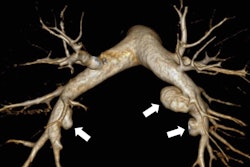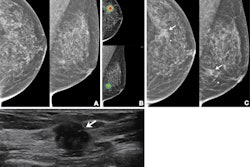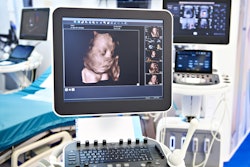Digital breast tomosynthesis (DBT) leads to earlier detection of breast cancer, a study published on 30 July in Radiology found.
Researchers led by Dr. Annika Jögi, PhD, from Skåne University Hospital in Lund, Sweden, analyzed data from women who were followed up through their first and second consecutive two-view digital mammography screening rounds after participating in the Malmö Breast Tomosynthesis Screening Trial (MBTST). They found that the cancer detection rate and the fraction of invasive cancers were lower in the first round and then increased in the second round.
“The reduced detection of less aggressive breast cancer subtypes with favorable prognosis in the first digital mammography screening round following a prospective [DBT] trial indicates screening benefit from tomosynthesis due to earlier detection of invasive cancer,” Jögi and colleagues wrote.
Despite DBT gaining ground on digital mammography for breast cancer screening, the latter is still considered the gold standard.
MBTST was a prospective, population-based paired study conducted between 2010 and 2015 that assessed the sensitivity and specificity of one-view DBT compared with two-view digital mammography in breast cancer screening. Findings indicated that DBT had a higher cancer detection rate, but more recalls than mammography.
Women participating in the trial were followed up through their first two consecutive routine mammography screening examinations. The researchers highlighted that analyzing how DBT screening impacts consecutive screening performance can estimate the modality’s future value in screening settings.
Jögi and fellow researchers studied how DBT adds to early breast cancer detection. They assessed cancer detection rates, including the fraction of invasive cancers and cancer subtypes in consecutive routine digital mammography. The team analyzed two follow-up screening rounds: the first round was performed 18 to 24 months after the MBTST, and the second round was performed 36 to 48 months after the trial.
MBTST had 14,848 participants with a median age of 57 years. Of these women, 12,876 were included in the first round of consecutive screening while 10,883 women were screened in the second round.
Cancer detection rates in MBTST were 6.5 (out of 1,000 women) for digital mammography and 8.7 for DBT. Also, the proportion of invasive cancers was 84.9%.
The team reported that the second round of consecutive screening led to more cancers being detected, including invasive cancers. Also, the odds of luminal A-like cancers were lower in the first round versus screening in the MBTST (p = 0.004), but higher in the second round (p = 0.52).
| Results of first and second rounds of consecutive screening after MBTST participation | ||
|---|---|---|
| Measure | First round | Second round |
| Cancer detection rate (out of 1,000) | 4.6 | 5.3 |
| Proportion of invasive cancers | 66% | 83% |
| Odds of luminal A-like cancers | 0.28 | 0.8 |
The study authors highlighted that the lower cancer detection rate and proportion of luminal A-like cancers in the first follow-up screening round points to earlier detection of slow-growing, less aggressive cancers.
“Less proliferative luminal A-like cancers may be diagnosed earlier and have a better prognosis with more sensitive screening, as they are subclinically present for a longer time,” they added.
However, the first follow-up screening round had a higher rate of interval cancers compared to the second round (2.2 per 1,000 vs. 1.5 per 1,000). The authors wrote that this suggests earlier detection of relevant fast-growing cancers at DBT, but they noted this should be interpreted with caution due to the small number of interval cancers found in the study.
The researchers concluded that they are performing a cost-effectiveness analysis of DBT screening at their institution.
In an accompanying editorial, Dr. Regina Hooley and Dr. Liane Philpotts from Yale School of Medicine wrote that the study's results are "noteworthy" and provide evidence on the value of DBT screening. They called for more studies to establish best practices, develop more personalized screening with DBT and mammography based on breast cancer risk, age, and breast density, and determine the added value of supplemental screening with other modalities.
"We need the data now, but even if provided with all the dedicated resources to support more long-term trials, it will take many years to solve the screening puzzle and someday end the screening mammography debate," they wrote.
The full results can be found here.




















